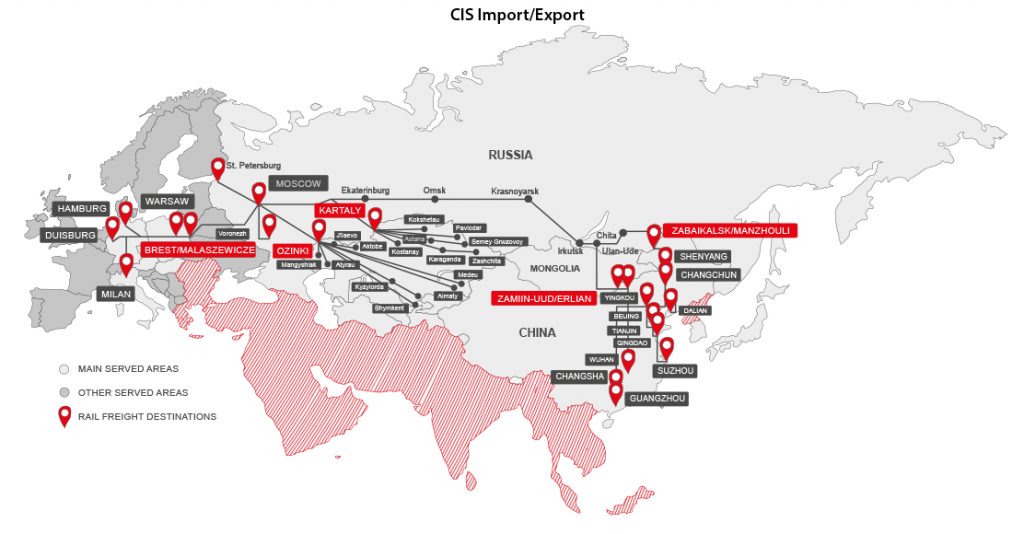Interview with Liliana Krutonog, chief executive officer of Far East Land Bridge (FELB)

Starting 2007, Far East Land Bridge (FELB) changed the rail transit transport system between Europe and China, by launching the first pilot project establishing its railway route based on the Trans-Siberian Railway linking the two continents. Throughout the years, the company has led negotiations and concluded the needed agreements to begin the transport services that are efficient and competitive with the maritime routes. As the first train service made its journey within 28 days, working to develop new solutions, the company has reached to a real transit time reduction to only 16-18 days, compared to the existing 20-22 days on maritime routes. Taking FELB railway transport services, the transit time is cut by half compared to the sea freight transport which brings obvious gains to its clients in terms of substantial cash flow advantage, flexibility and reduced delivery time. Thus, FELB is currently offering an alternative to the sea and air transport on the routes between China, South Korea and Europe.
FELB’s services are targeted for the clients with high – value goods or urgent shipments, located in areas easily connected to the rail, as congestion in and around Chinese / European ports is avoided, allowing a direct and fast door-to-door connection. The departures are provided daily, but they can also be adapted to specific demands if block-train volumes are provided – per container, a gross weight of up to 30 tonnes is allowed. The cargoes vary from raw materials and textiles to automotive parts, solar panels, and all kind of high-tech devices. The products are transported for mega – companies such as BMW, Audi, Volkswagen, Samsung or LG, which are continuously using the railway transport services.
Although 2020 was a difficult year, as the pandemic has started and many industries have been closed or worked at a low capacity as the restrictive measures were put in place to limit the spread of the coronavirus, FELB recorded a growth of 42% last year. In 2020, FELB transported more than 105,000 TEU, and recorded a revenue of USD 185 million. The company has been involved to transport medical equipment supporting the essential deliveries. For example, the operator has delivered medical devices from Nanchang (Jiangxi Province, Eastern China) to Paris in collaboration with Russian Railways Logistics, SNCF Forwardis, Cosco group and UTLC ERA. Within 20 days, the first train of 41 x 40-foot containers carrying medical supplies – such as 40 million medical masks, gloves, gel dispensers and other protective equipment, destined for hospitals and local authorities, arrived from China to France. The train used the southern transit route operated by UTLC ERA crossing Kazakhstan. FELB acted as the coordinator of partner negotiations in China and Europe.
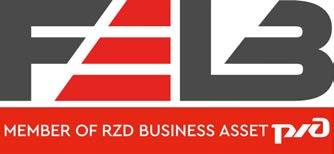 Also, in 2020, FELB added a new connection on its transit map: Austria. In April, the first block – train from Shenyang, China arrived in Enns, Austria, under collaboration with Sinotrans. The train entered Russian rail network via Manzhouli / Zabaikalsk, then using the Trans-Siberian route, it reached Brest / Malaszewicze cross border within seven days. From there the train was sent to Enns, the final destination. The train was formed of 41 x 40 HC container carrying raw materials for an Austrian company. The block – train arrived at the Container Terminal Enns (CTE) situated in one of the strongest industrial regions in Austria, being positioned as a trimodal trans-shipment terminal, as part of the Ennshafen port. Its infrastructure, roads, quays and rail facilities give companies access to all transport modes. CTE with 275,000 square meters of space and a capacity of more than 500,000 TEU (twenty-foot equivalent units), is one of the most modern Container handling infrastructures in Austria.
Also, in 2020, FELB added a new connection on its transit map: Austria. In April, the first block – train from Shenyang, China arrived in Enns, Austria, under collaboration with Sinotrans. The train entered Russian rail network via Manzhouli / Zabaikalsk, then using the Trans-Siberian route, it reached Brest / Malaszewicze cross border within seven days. From there the train was sent to Enns, the final destination. The train was formed of 41 x 40 HC container carrying raw materials for an Austrian company. The block – train arrived at the Container Terminal Enns (CTE) situated in one of the strongest industrial regions in Austria, being positioned as a trimodal trans-shipment terminal, as part of the Ennshafen port. Its infrastructure, roads, quays and rail facilities give companies access to all transport modes. CTE with 275,000 square meters of space and a capacity of more than 500,000 TEU (twenty-foot equivalent units), is one of the most modern Container handling infrastructures in Austria.
Routes:
FELB Eurasian services between Europe and China are using the Trans-Siberian railway, with over 9,500 km crossing Russia, Belarus and Ukraine. In Europe, on the northern route, the gauge changing (from broad to standard gauge) is ensured by the terminals in Belarus (Brest terminal), Poland (Małaszewicze terminal), while on the south axis, three terminals are providing this connection, one in Ukraine (Chop terminal), in Slovakia (Dobrá) and in Hungary (Záhony). On the other side, in the Far East, the transit services are provided at the cross-border point in Russia (Sabaikalsk, District of Zabaykalsky Krai, situated at the Chinese – Russian border) and at the Chinese border, the transit is ensured in Manzhouli. In addition, there is the southern connection at Kazakhstan – China border (Dostyk / Alashankou point) via which the trains are sent to Chongqing, a focal trade point. The route via Vostochny, in Amur Oblast in the Russian Far East, is mainly used to connect South Korean and Chinese ports for shipping up to 30 TEU per transport.
Thus, on the Eurasian route, FELB provides transport services on the East – West axis, serving 8 destinations in Asia and two connection ports, towards European countries such as Poland (Warsaw), Italy (Milan), Germany (Duisburg and Hamburg – as a port connection destination).
On the rail freight route from China to the western Russia’s region, FELB links three main destinations – St. Petersburg, Moscow and Vorsino in Kaluga Oblast with five destinations in China (Donggauan, Guangzhou, Ganzhou, Chengdu and Nanjing). The FCL (Full Container Load) transit time has an average of 14-16 days.
FELB is also supporting the CIS import / export activities serving not only main areas, but also other areas on the route from China to Europe, providing essential connections in Mongolia, Kazakhstan, Uzbekistan.
Now more than ever, when sustainability is at the heart of the transport system, rail being the most friendly – environmental transport mode, FELB is focusing to develop its services to promote this means of transport. The rail Land Bridge route saves 75% of the maritime route’s carbon footprint, and at the same time is reducing by half the distance covered. For example, the rail transit services are covering 11,000 km in maximum three weeks with only 3.5 kg of CO2 / TEU, while the maritime route has a length of 20,000 km covered in more than five weeks, emitting 2.5 kg CO2 / TEU. By air, the 8,500 km route is covered in max. 7 days, but the CO2 emission is very high (44 kg CO2 / TEU), compared to the other transport modes. The railway transport services provided by FELB also use electrified lines where they exist contributing to the reduction of the emissions, avoids the congestion in the ports areas and promotes modal shift to rail.
Far East Land Bridge Ltd. specialises in transporting 40-foot DV, HQ and 20-foot containers between the Far East (China, South Korea, and Japan) and Russia and Europe via the Trans-Siberian railway. The company has come a long way in recent years, increasing the frequency of rail shipments from one per week to six.
Far East Land Bridge maintains 6 offices in China, an office in Kazakhstan, regional representations in Italy and Germany, while the head office is situated in Europe, in Vienna. Over a hundred employees ensure the company’s smooth operation and the effective sale of its services.
Customers of the company gain a substantial financial benefit from the reduction of transit times compared with the alternative sea route, averaging up to 22 days.
Liliana Krutonog, named the Chief Executive Officer of Far East Land Bridge Ltd in August 2020 is providing us more details on FELB activities, development plans and the way the company is facing the challenges. One of the new director’s key responsibilities was to design and implement a new development strategy, including in European countries and China.
Liliana Krutonog has extensive experience of working with major international company groups. She worked on intermodal transport for the Rail Cargo Group (Austria) for over 12 years. Between 2016 and 2018 she held the role of director of intermodal transport for a subsidiary of Czech Railways in Poland, working on the development of freight traffic in the border zone on the standard 1435 mm track gauge.
From 2018 to 2020 Liliana Krutonog was head of the eastern division of the CD Cargo Group (Czech Republic), where she managed a complex development strategy for the Czech railway system towards Russia, the CIS countries and China. She was also an authorised representative of Czech Railways within the framework of China’s international One Belt and One Road initiative, which seeks to improve existing and create new trade routes, transport and economic corridors that will link over 60 countries in Central Asia, Europe and Africa.
Ms Krutonog, you took up your position as CEO of Far East Land Bridge (FELB) at a very difficult time in mid-2020. The difficulties of doing business during the COVID-19 pandemic, with countries in lockdown and restricted access across borders – how did this affect the transport and logistics services of FELB and your activities in this new stage of your career?
Without a doubt, the coronavirus pandemic left its mark on the development of logistics services and affected the activities of FELB, but nevertheless, I would like to point out that despite these difficult circumstances we were able to exceed our budget by almost 100%, opening up new markets and embarking on a large number of new projects.
Among the most significant of these are projects carried out with the Shandong and Jinhua provinces of the People’s Republic of China and also direct agreements signed with a number of Chinese logistics platforms that have now become partners for us in China.
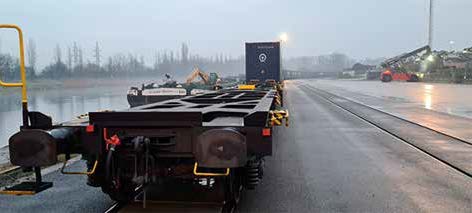
As for strengthening our position in Europe, FELB began to lease standard 1435-mm European-gauge wagons for the first time in the company’s history, to optimise transport within Europe. We are planning to further add to our fleet of wagons in 2021 within various new projects.
I would also mention that we have signed a strategic cooperation agreement with CD Cargo Logistics, a subsidiary of Czech Railways, resulting in the addition to the product portfolio of FELB of services from key terminals in Eastern Europe – specifically in the Czech Republic (Brno, Obrnice, Kolín with exclusive conditions of use), plus Wrocław in Poland.
What are the current volumes of transit container shipments and how are they evolving?
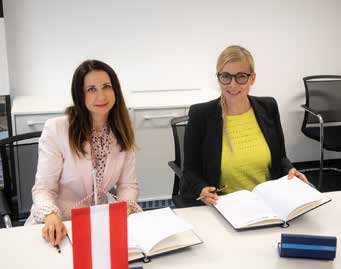
Liliana Krutonog, CEO of FELB; Jana Mlkvá, chairperson of the board of directors of CD Cargo Logistics
Despite the pandemic, 2020 overall was a record for FELB compared to recent years: we transported 105,000 TEU, representing a growth in 2020 of 30,920 TEU or +42%, which resulted in a substantial growth for the company in sales revenues of 28%. All this became possible thanks to the efficient and well-coordinated work of the various teams at FELB, in the Austrian and Chinese offices.
Also, it is worth pointing out that this positive result is linked to a general growth in freight containerisation and an increase in international container traffic. I would stress that this growth in shipments has been made possible by the active development of technology for faster container trains that have enabled railways to become competitive with sea transport, and our services are actively sought after by the owners of high-value freight in Europe and China, for whom delivery times and the minimisation of the periods in which their funds are blocked in bank accounts are of primary importance.
And although it may seem strange, the COVID-19 pandemic has had certain positive effects for rail transit. Because of the coronavirus quarantine restrictions in most countries of the world and the difficulty of providing empty containers at the places of origin of the freight, the unit charges for container transport by sea have increased substantially, resulting in turn in a significant channelling of freight onto the railway, which is now seen as the most stable and reliable mode of transport.
I would point out here that the key factor for any further increase in the competitiveness of rail transit services between China and Europe in the near future will be the speed of delivery of freight, marked in the first instance by the daily route speed of container trains, and I would like to mention the successes of the Russian railways in systematically addressing this task.
FELB is known in the market as one of the largest international transit operators. Recently you changed the company logo and redesigned the website. Why was this necessary? What are the new projects and approaches to the logistics business that you intend to embark on in this new phase of development?
Changes to the company logo were suggested some time ago, and I think 2020 was the right time – for that year is remembered by all of us for numerous changes, both at work and in our everyday lives.
In designing the new logo, we tried to approach the colours of the Russian Railways’ logo ‘РЖД’ (RZD) – and I think we did reasonably well. We also updated the company website.
Among the new projects we intend to complete, I would particularly like to mention our plans to increase FELB’s business in Eastern Europe and also new projects in the southern regions of Europe.
What else do you need to undertake in order to continue moving as fast as you were moving in 2020 and to accelerate the development of the business? How do you see the company in a year’s time and in terms of its strategy up to 2025?
Last year was characterised by an acute shortage of equipment – specifically, of containers carrying Chinese freight. We felt this particularly towards the end of the year, when we were unable to transport some of the freight of our regular customers from China. The situation was made more difficult by the fact that the Chinese railways changed some of the slots for trains destined from China to Europe.
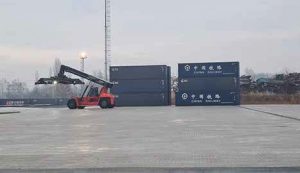 Because of this, one of the most important steps for us is to expand the fleet of FELB containers in the next few years. We also need to increase the number of wagons owned by us or available to us on long-term lease.
Because of this, one of the most important steps for us is to expand the fleet of FELB containers in the next few years. We also need to increase the number of wagons owned by us or available to us on long-term lease.
In this regard, I would mention that in 2020 our main shareholder changed to the joint stock company ‘RZD BusinessActive’, set up in November 2020 and that is a 100% subsidiary of RZD Logistics.
Every month our parent company is increasing its fleet of platform 1,520-mm wagons and we are placing our hopes on their reliability and support in 2021. According to plans that have been disclosed, by 2024-2025 RZD BusinessActive aims to have a rolling stock of the order of 32,000 well wagons and 95,000 high-capacity containers. As for FELB, we are ready to increase our ‘fleet’ of standard-gauge 1,435-mm wagons, which are crucial to enable quick and seamless border crossings and efficient reloading of trains without our own stock.
We are seeking to increase the number of express freight trains and to broaden the range of freight transported. We have built up a body of experience in operating container trains with specialised containers, and to manage these projects effectively we also use a well-established network of our own representatives and agent partners in the various countries of Europe, Russia, the CIS states and the Asia-Pacific region.
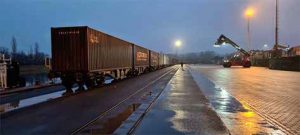
Taking these factors into account, we are working together with our partners on developing a range of measures for attracting container transit movements along the routes of the ‘East-West’ transport corridor, including working with the leaders of the Chinese provinces to maintain Chinese subsidies for container transport up to 2024 and beyond, and addressing questions of updating the border crossings and border services in Belarus, Russia and China, accelerating the handling of freight streams at the borders and developing terminals close to borders.
Given the development of industry clusters in northern and north-western China and also the partnering in recent years of the economies of neighbouring countries and the fact that the rate of development of Chinese foreign trade with European countries will only increase as a result of the Chinese government’s One Belt and One Road initiative, we are expecting to significantly increase the volumes of our trains and to broaden our transport directions and routes. And we are wholly looking forward to participating in this interesting and far-reaching activity.
Thank you, Ms Krutonog, for your interview, which will be of great interest to our readers. We wish you success in developing the business and implementing new projects.
- 2020 was a record year for FELB: we transported 105,000 TEU – which was 30,920 TEU, or 42% more than for any analogous period in previous years;
- Our services are actively sought after by the owners of high-value freight in Europe and China, for whom delivery times and the minimisation of the periods in which their funds are blocked in bank accounts are of primary importance;
- In designing the new logo we tried to approach the colours of the Russian Railways’ logo ‘РЖД’ (RZD) We also updated the company website
Share on:



